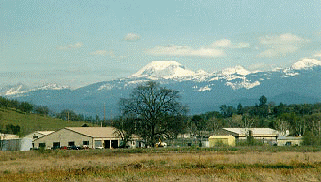
Coleman National Fish Hatchery
Encyclopedia

Shasta Dam
Shasta Dam is an arch dam across the Sacramento River in the northern part of the U.S. state of California, at the north end of the Sacramento Valley. The dam mainly serves long-term water storage and flood control in its reservoir, Shasta Lake, and also generates hydroelectric power...
and Keswick Dams, Chinook Salmon
Chinook salmon
The Chinook salmon, Oncorhynchus tshawytscha, is the largest species in the pacific salmon family. Other commonly used names for the species include King salmon, Quinnat salmon, Spring salmon and Tyee salmon...
and Steelhead Trout were free to migrate to the upper reaches of the Sacramento
Sacramento River
The Sacramento River is an important watercourse of Northern and Central California in the United States. The largest river in California, it rises on the eastern slopes of the Klamath Mountains, and after a journey south of over , empties into Suisun Bay, an arm of the San Francisco Bay, and...
, Pit
Pit River
The Pit River is a major river draining from northeastern California into the state's Central Valley. The Pit, the Klamath and the Columbia are the only three rivers in the U.S...
and McCloud River
McCloud River
The McCloud River is a river that flows east of and parallel to the Sacramento River, long, in northern California in the United States. It drains a scenic mountainous area of the Cascade Range north of Redding...
s to spawn. In 1942, the Coleman National Fish Hatchery (Coleman NFH) was established under an act of the U.S. Congress to mitigate the loss of historic spawning habitat caused by the construction of the dams. The hatchery is located in Shasta County, California
Shasta County, California
Shasta County is a county located in the northern portion of the U.S. state of California. The county occupies the northern reaches of the Sacramento Valley, with portions extending into the southern reaches of the Cascade Range. As of the 2010 census, the population was 177,223, up from 163,256...
near the town of Anderson
Anderson, California
Anderson is a city in Shasta County, California, USA, approximately 10 miles south of Redding. The population was 9,932 at the 2010 census, up from 9,022 at the 2000 census....
on the north bank of Battle Creek approximately six river miles east of the Sacramento River. Coleman NFH covers approximately 75 acres (303,514.5 m²) of land owned by the U.S. Fish and Wildlife Service (USFWS), with an additional 63 acres (254,952.2 m²) of land in perpetual easements for pipelines and access.
Chinook salmon (Oncorhynchus tshawytscha) and steelhead (Oncorhynchus mykiss) returning from the ocean, travel up the Sacramento River and Battle Creek where they are enticed by water flow into the fish hatchery. Eggs are collected, fertilized and incubated artificially until they hatch. The young fish are then raised in ponds at the hatchery until they are sufficient size to be released and return to the ocean. Long term production goals for Coleman NFH Complex are as follows: 12,000,000 fall Chinook salmon, 1,200,000 late-fall Chinook salmon, 250,000 winter Chinook salmon, and 600,000 steelhead annually. Winter Chinook salmon are reared at the Livingston Stone National Fish Hatchery, a sub-station of Coleman NFH, located at the base of Shasta Dam.
Coleman NFH was constructed in 1942 as a mitigation measure to preserve Chinook salmon populations following construction of Shasta Dam. Shasta Dam permanently blocked approximately 50% of key spawning and rearing habitat(s) for Chinook salmon and steelhead (Skinner 1958). The Shasta Salvage Plan authorized the construction and operation of a fish hatchery (Moffett 1949; Black 1999) to offset natural production losses. Fish production began at Coleman NFH in 1943. Production objectives for Coleman NFH include two runs of salmon and steelhead. The facility goal(s) are to ensure contribution from upper Sacramento River salmonid populations to commercial (ocean) and sport fisheries (ocean and river). Coleman NFH contributes substantially to the multi-million dollar commercial and recreational fishing industry in California.
Three intake structures and associated conveyance facilities are used to divert and convey water directly from Battle Creek and the Coleman Powerhouse tailrace (Figure 1). The primary intake (1) is located within the tailrace of Pacific Gas and Electric’s (PG&E) Coleman Powerhouse, on the north bank (Figure 2). Intake water is transferred through a 46-in. conveyance pipe and diverted into Coleman Canal. The secondary intake (2) is located on the south bank of Battle Creek (across from intake 1). Intake 2 shares the conveyance pipe with intake 1 and diverts water to Coleman Canal. Intake 2 serves as an emergency back-up water diversion structure for intake 1, supplying water to Coleman Canal 17 days annually (10-year average 1990-2000). Intake 1 and 2 are approximately 1.6 miles (2.6 km) upstream of Coleman NFH. Intake 3 is 1.2 miles (1.9 km) upstream from Coleman NFH and acts as the tertiary diversion for the hatchery. Water is diverted 4600 feet (1,402.1 m) from Intake 3 to the hatchery through 48-in pipe. Water from all intakes may be diverted to the ozone facility or sent directly to hatchery rearing units at Coleman NFH

